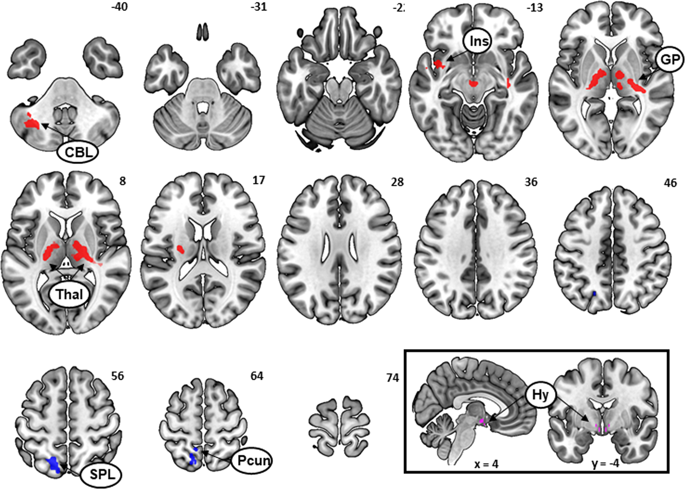当前位置:
X-MOL 学术
›
Int. J. Obesity
›
论文详情
Our official English website, www.x-mol.net, welcomes your
feedback! (Note: you will need to create a separate account there.)
The interrelationship of body mass index with gray matter volume and resting-state functional connectivity of the hypothalamus.
International Journal of Obesity ( IF 4.2 ) Pub Date : 2019-12-03 , DOI: 10.1038/s41366-019-0496-8 Thang M. Le , Ding-Lieh Liao , Jaime Ide , Sheng Zhang , Simon Zhornitsky , Wuyi Wang , Chiang-Shan R. Li
International Journal of Obesity ( IF 4.2 ) Pub Date : 2019-12-03 , DOI: 10.1038/s41366-019-0496-8 Thang M. Le , Ding-Lieh Liao , Jaime Ide , Sheng Zhang , Simon Zhornitsky , Wuyi Wang , Chiang-Shan R. Li

|
BACKGROUND
The hypothalamus plays an important role in regulating body weight through its interactions with multiple brain circuits involved in distinct aspects of feeding behavior. Yet, how hypothalamic gray matter volume (GMV) and connectivity may be related to individual differences in body weight remains unclear. We tested the hypothesis that the hypothalamus shows enhanced resting-state functional connectivity (rsFC) with regions of the reward, motivation, and motor circuits in positive correlation with body mass index (BMI) and the opposite with those associated with inhibitory control. We further examined the interdependent relationships between hypothalamic GMV, connectivity, and body weight.
METHODS
Using seed-based rsFC and voxel-based morphometry analyses, we examined the relationship between the rsFC and GMV of the hypothalamus and BMI in 105 healthy humans. Additionally, we employed mediation analyses to characterize the inter-relationships between hypothalamic connectivity, GMV, and BMI.
RESULTS
A whole-brain multiple regression showed that BMI was positively correlated with hypothalamic rsFC with the insula, thalamus, globus pallidus, and cerebellum, and negatively correlated with hypothalamic rsFC with the superior parietal lobule. Thus, higher BMI was associated with enhanced hypothalamic connectivity with regions involved in motivated feeding and reduced connectivity with those in support of cognitive control of food intake. A second whole-brain multiple regression revealed a positive correlation between hypothalamic GMV and the hypothalamus-posterior insula connectivity. Finally, the relationship between hypothalamic GMV and BMI was significantly and bidirectionally mediated by the hypothalamus-posterior insula connectivity.
CONCLUSIONS
The current findings suggest that the hypothalamus differentially interacts with the motivation, motor, and control circuits to regulate BMI. We further found evidence for the interdependence of hypothalamic structure, function, and body weight, which provides potential insights into the brain mechanisms of obesity.
中文翻译:

体重指数与灰质体积和下丘脑静息状态功能连接的相互关系。
背景下丘脑通过与涉及进食行为不同方面的多个大脑回路的相互作用在调节体重方面发挥重要作用。然而,下丘脑灰质体积 (GMV) 和连通性如何与体重的个体差异相关仍不清楚。我们测试了下丘脑显示增强的静息状态功能连接 (rsFC) 与奖励、动机和运动回路区域与体重指数 (BMI) 正相关而与抑制控制相关的区域相反的假设。我们进一步研究了下丘脑 GMV、连通性和体重之间的相互依赖关系。方法使用基于种子的 rsFC 和基于体素的形态测量分析,我们检查了 105 名健康人的下丘脑 rsFC 和 GMV 与 BMI 之间的关系。此外,我们采用中介分析来表征下丘脑连通性、GMV 和 BMI 之间的相互关系。结果 全脑多元回归显示,BMI 与下丘脑 rsFC 与脑岛、丘脑、苍白球和小脑呈正相关,与下丘脑 rsFC 与顶上小叶呈负相关。因此,较高的 BMI 与下丘脑与参与主动喂养的区域的连通性增强以及与支持对食物摄入的认知控制的区域的连通性降低有关。第二次全脑多元回归显示下丘脑 GMV 与下丘脑-后脑岛连接之间呈正相关。最后,下丘脑 GMV 和 BMI 之间的关系是由下丘脑 - 后脑岛连接显着双向介导的。结论 目前的研究结果表明,下丘脑与动机、运动和控制回路的相互作用不同,以调节 BMI。我们进一步发现了下丘脑结构、功能和体重相互依赖的证据,这为肥胖的大脑机制提供了潜在的见解。
更新日期:2019-12-03
中文翻译:

体重指数与灰质体积和下丘脑静息状态功能连接的相互关系。
背景下丘脑通过与涉及进食行为不同方面的多个大脑回路的相互作用在调节体重方面发挥重要作用。然而,下丘脑灰质体积 (GMV) 和连通性如何与体重的个体差异相关仍不清楚。我们测试了下丘脑显示增强的静息状态功能连接 (rsFC) 与奖励、动机和运动回路区域与体重指数 (BMI) 正相关而与抑制控制相关的区域相反的假设。我们进一步研究了下丘脑 GMV、连通性和体重之间的相互依赖关系。方法使用基于种子的 rsFC 和基于体素的形态测量分析,我们检查了 105 名健康人的下丘脑 rsFC 和 GMV 与 BMI 之间的关系。此外,我们采用中介分析来表征下丘脑连通性、GMV 和 BMI 之间的相互关系。结果 全脑多元回归显示,BMI 与下丘脑 rsFC 与脑岛、丘脑、苍白球和小脑呈正相关,与下丘脑 rsFC 与顶上小叶呈负相关。因此,较高的 BMI 与下丘脑与参与主动喂养的区域的连通性增强以及与支持对食物摄入的认知控制的区域的连通性降低有关。第二次全脑多元回归显示下丘脑 GMV 与下丘脑-后脑岛连接之间呈正相关。最后,下丘脑 GMV 和 BMI 之间的关系是由下丘脑 - 后脑岛连接显着双向介导的。结论 目前的研究结果表明,下丘脑与动机、运动和控制回路的相互作用不同,以调节 BMI。我们进一步发现了下丘脑结构、功能和体重相互依赖的证据,这为肥胖的大脑机制提供了潜在的见解。











































 京公网安备 11010802027423号
京公网安备 11010802027423号